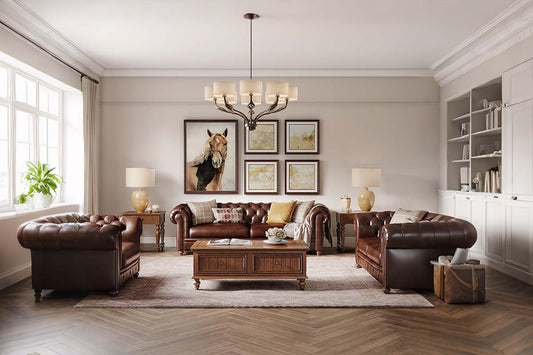
Are Crossed Leg Office Really Comfortable and Healthy?
Share
You've probably seen them on Instagram or Pinterest—sleek, minimalist chairs designed for sitting cross-legged, sometimes called meditation chairs, floor chairs, or Zafu-style seats. They look cozy, laid-back, and maybe even healthier than the average office chair.
But here’s the real question:
Are cross-legged chairs actually good for your body, or are they just another design trend that feels great—for about 20 minutes?
This guide explores the core of cross-legged chairs—their benefits, evolution, and how they fit into today’s pursuit of comfort and spinal health.

Understanding Chair Ergonomics: Why Cross-Legged Chairs Deserve a Closer Look
Ergonomics isn’t just about comfort—it’s about supporting the body’s natural structure. Cross-legged chairs blend ancient sitting postures with modern ergonomic principles to create a seating option that works with your body.
Why consider a cross-legged chair?
-
Supports spinal alignment: Encourages an upright S-curve posture, helping reduce lower back pain and long-term strain.
-
Promotes active sitting: Engages core muscles, encouraging mindful posture habits.
-
Encourages movement: Unlike rigid chairs, they allow frequent position shifts, reducing stiffness and boosting circulation.
-
Merges tradition and innovation: Grounded in yoga and meditation, these chairs are reimagined for today’s flexible, wellness-focused lifestyles.
A great chair should do more than look good—it should help you move, think, and feel better throughout the day.
What Is a Cross-Legged Office Chair? Origins and Modern Purpose
The cross-legged office chair—also called a “meditation desk chair” or “floor-style chair”—is designed to let you sit comfortably with legs crossed or tucked. It typically features:
-
A wider, flatter seat to accommodate legroom
-
Low or armless frames for freedom of movement
-
Optional lumbar support for better spinal health
Ancient Roots
Cross-legged sitting has been part of daily life in Asia and the Middle East for centuries—for meals, meditation, and social gatherings. These postures naturally promote spine alignment and core engagement.
Modern Evolution
As more people work from home and embrace wellness routines, seating preferences have shifted. Cross-legged chairs offer a middle ground between functionality and mindful living.
More Than a Trend
This seating style reflects a broader desire to reconnect with how the body naturally prefers to sit—while still aligning with modern aesthetics and workflow demands.
Benefits of Using a Cross-Legged Office Chair
Cross-legged chairs, when used thoughtfully, can offer both physical and mental advantages:
1. Better Posture & Spinal Health
By supporting the spine’s natural curves and encouraging upright sitting, these chairs may help reduce slouching and long-term back issues.
2. Improved Circulation & Muscle Engagement
They encourage active sitting—subtle movements that keep blood flowing and core muscles activated, helping reduce stiffness and fatigue.
3. Enhanced Mental Focus
The cross-legged position is linked to mindfulness and clarity. Reducing physical tension can help you stay more present and focused—whether working or meditating.
4. Aesthetic and Lifestyle Fit
These chairs fit seamlessly into modern homes with their minimalist designs, while also promoting a lifestyle of comfort, intention, and conscious movement.
So, Are Cross-Legged Chairs Truly Ergonomic?
Yes—in the right context.
While they don’t replace traditional ergonomic office chairs, they complement them by offering alternative ways to sit that feel more natural and engaging. The best cross-legged chairs:
-
Respect spinal alignment
-
Encourage frequent position changes
-
Offer flexibility in casual or meditative settings
Used mindfully, they reflect an evolved, dynamic view of ergonomics—one that values movement, variety, and body awareness.

How to Choose the Right Cross-Legged Chair
Selecting the right chair involves balancing form and function. Here’s what to look for:
1. Prioritize Ergonomic Support
Choose a chair that aligns with your spine and distributes weight evenly. Look for back support if you’ll be using it for work or longer sessions.
2. Assess Cushioning & Fabric
Opt for durable, breathable materials and padding that suits your sitting habits—soft for relaxation, firmer for posture support.
3. Look for Adjustability
Features like adjustable height, tilt, or removable cushions make the chair more versatile for different tasks or sitting durations.
4. Check Sizing & Space
Make sure the seat is wide enough for your frame and suits your room’s dimensions. Lightweight or foldable options work well in small spaces.
5. Match Your Interior Style
From earthy to ultra-modern, choose a chair that complements your home’s design so it feels like a natural part of the space.
6. Read Reviews & Compare Options
User experiences help identify potential issues with comfort, durability, or design quirks you might not notice at first glance.
7. Understand Return Policies
Buy from retailers with flexible returns or trial periods—especially if you’re not sure whether cross-legged sitting suits your body.
How to Use a Cross-Legged Chair in Daily Life
1. Take Mindful Breaks
Use the chair for meditation, journaling, or short reading sessions—times when you want to relax and recenter.
2. Alternate with Ergonomic Seating
Don’t replace your primary work chair entirely. Rotate between a traditional ergonomic chair and your cross-legged seat for posture variety.
3. Use It in Casual Spaces
They’re great for reading nooks, quiet corners, or creative studios where laid-back sitting is welcome.
4. Avoid Long-Hour Sessions
Extended cross-legged sitting can restrict circulation. Use in shorter bursts or adjust your posture frequently.
5. Incorporate Movement
Stand up, stretch, or change positions every 30–45 minutes to keep muscles active and improve blood flow.
Cross-Legged Chair FAQ: Common Questions & Solutions
Q1: Is it bad for my back to sit cross-legged?
A: Not inherently. With proper posture and short sessions, it can improve alignment. But prolonged sitting without movement can cause strain—balance is key.
Q2: Are cross-legged chairs suitable for working long hours?
A: Not on their own. They’re best for light tasks, reflection, or breaks. Use in combination with ergonomic seating.
Q3: What’s the best material?
A: High-density foam with breathable fabric or leatherette is ideal for comfort and durability.
Q4: My legs get numb or tingly when sitting cross-legged—what can I do?
A: This can happen if blood flow is restricted. Try adjusting your leg position regularly, avoid crossing too tightly, and take standing breaks to improve circulation.
If you have more questions or want personalized advice on which cross-legged chair suits your lifestyle best, feel free to ask!
In Conclusion
Cross-legged chairs offer a unique blend of comfort, style, and ergonomic benefits when used thoughtfully. They’re ideal for short breaks, meditation, and casual relaxation, helping promote better posture, circulation, and mental focus. However, like any seating option, balance and moderation are key—pairing cross-legged chairs with traditional ergonomic seating and regular movement will help you enjoy their benefits without discomfort or strain.
We also invite you to join us in exploring and sharing even more creative ways to enjoy cross-legged chairs—whether it’s in workspaces, wellness routines, or everyday moments of rest.



